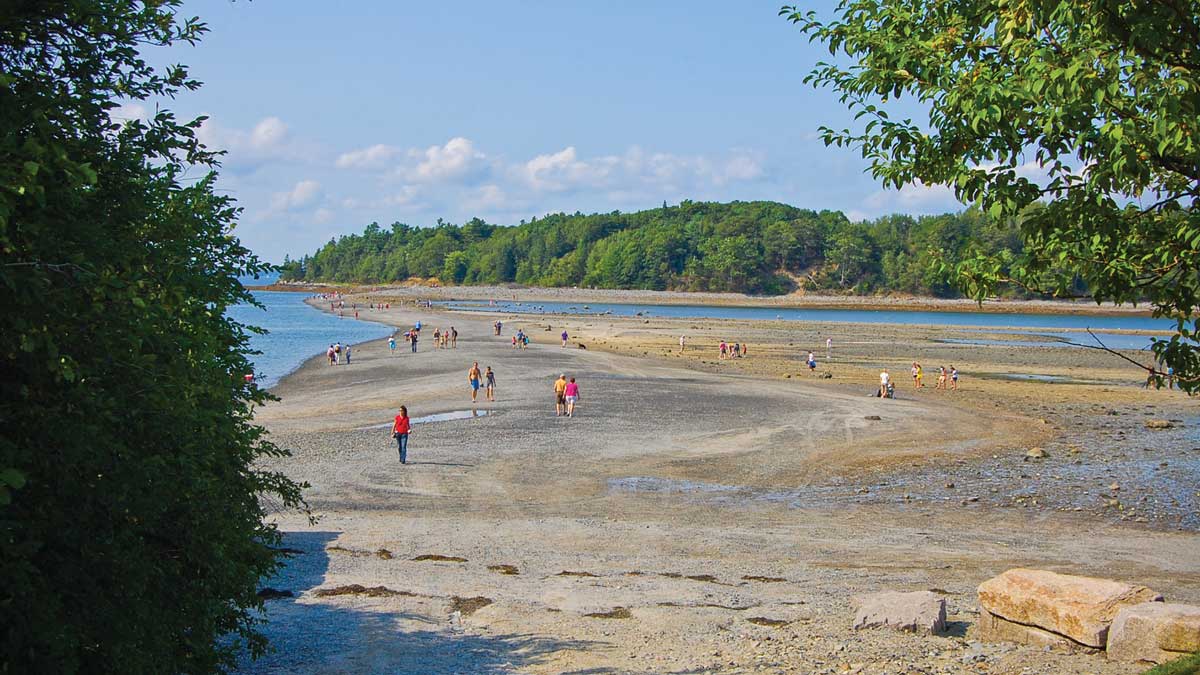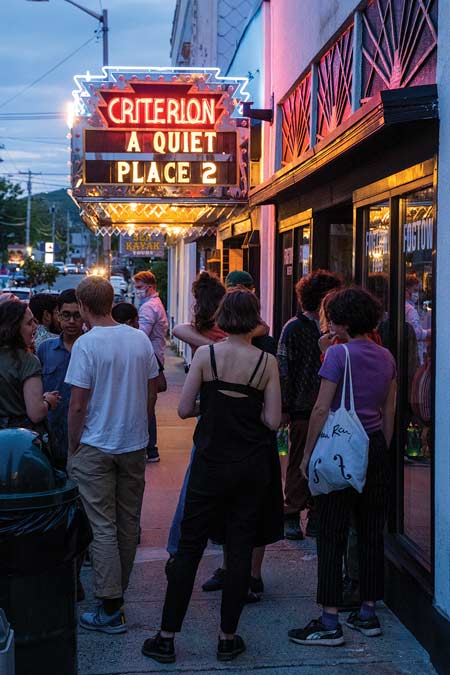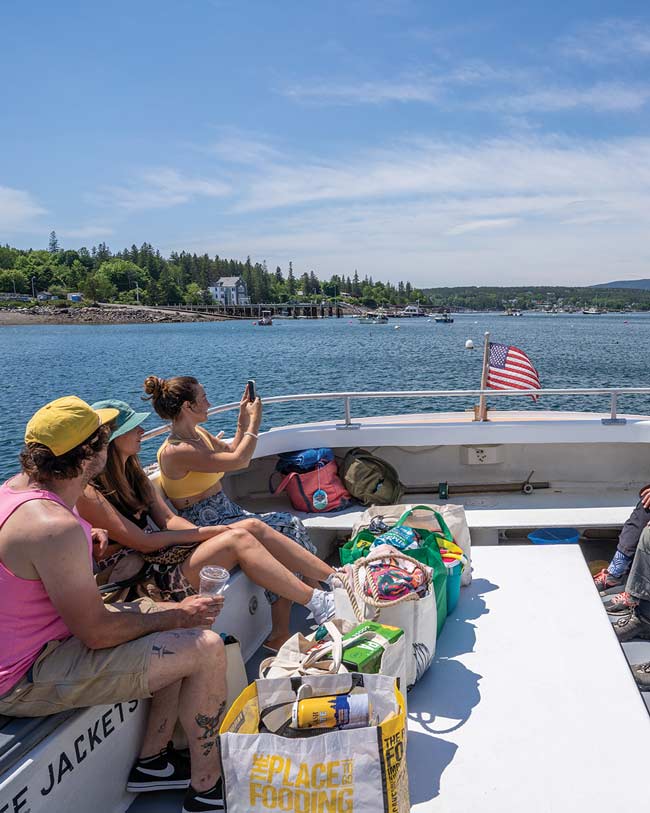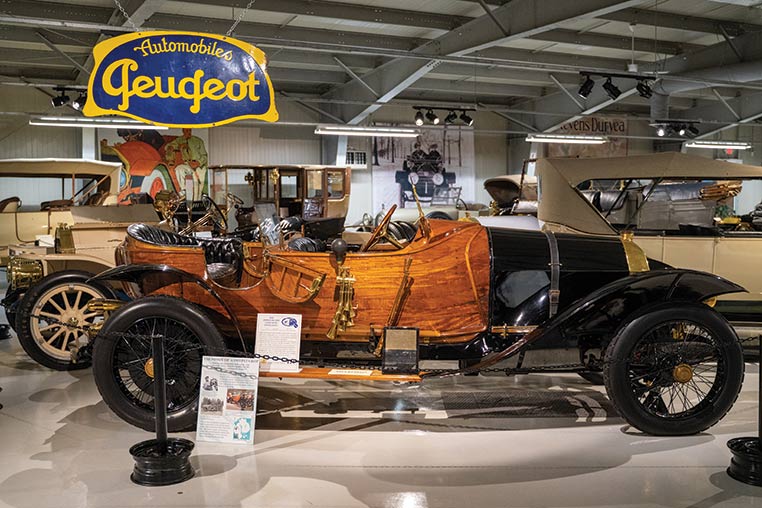From our August 2021 issue
You’d be forgiven for thinking that Mount Desert Island was synonymous with Acadia National Park. The two often get used interchangeably, what with the park’s 47,000 acres covering more than half of the island. But MDI’s magic extends far beyond Acadia’s jagged coastal cliffs and piney peaks to its four towns — Bar Harbor, Tremont, Southwest Harbor, and the town of Mount Desert — along with the outlying Cranberry Isles, a short ferry ride away.
Taken together, these communities possess the best that Maine has to offer: striking vistas, working waterfronts, charming downtowns, and a mix of summer residents and long-time locals working hard to preserve what makes Mount Desert Island great. Each town has a unique story, a distinctive vibe, and many treasures to explore.
Bar Harbor

By Adrienne Perron
Photos by Ryan Hyde & Benjamin Williamson
The gateway to Maine’s marquee national park, Bar Harbor sometimes gets a bad rap as a crowded tourist trap that shuts down after Indigenous Peoples’ Day. But while MDI’s biggest town has its share of souvenir kitsch, it offers a whole lot else — natural splendors, architectural landmarks, and plenty of elbow room if you know where and when to go.
Aptly incorporated in 1796 as Eden, the town became, by the 1880s, a summer playground for wealthy rusticators seeking refuge from noisy, polluted cities. The Pulitzers, Vanderbilts, and Morgans built mansions dubbed “cottages” there. While many of those not-so-humble abodes were destroyed by the Great Fires of 1947, the town still teems with homes, churches, and landmarks erected during its golden age. Thanks to generations worth of preservationism, many of these once-exclusive edifices — and the idyllic spots that attracted their owners here — are now easily accessible from the bustling downtown.

The Shore Path, a 1.2-mile walkway hugging the coastline, starts right from the town wharf and offers stunning views of Frenchman Bay and the spruce-studded Porcupine Islands, as well as close-ups of sprawling seaside estates like the nearly 120-year-old English Tudor–style mansion known as the Breakwater Estate, which was built for a grandson of John Jacob Astor. Informational plaques along the way tell the stories of notable people and events in the town’s history.
Just up the street from the town wharf, the Bar Island Trail follows a sandbar that emerges at low tide, providing an easy, Moses-like walk across the parted sea and over to Bar Island, where a network of wooded trails leads to impressive views of the town and the bay.
The ultimate place to get some space, though, is on the water. Multiple boat tours embark from the town wharf, with passengers watching for whales and seabirds or, on lobsterboats, learning how Maine’s signature crustacean is caught.
Timing, of course, is everything. Savvy visitors know that Bar Harbor is especially sweet after summer ends. An increasing number of restaurants and shops stay open year-round, and in recent years events like December’s Village Holidays and January’s Winter Beer Fest have made the off-season especially festive. Organizations like Jesup Library and Abbe Museum stay open. The Criterion Theatre, built in 1932, screens films and concerts all year long.
Don’t Miss
The Abbe Museum. Maine’s only Smithsonian affiliate celebrates the history and culture of Maine’s native Wabanaki tribes. 26 Mt. Desert St. 207-288-3519.
Museum in the Streets. This self-guided walking tour includes 29 placards that tell the story of the people and events that shaped the town’s fascinating history. Start at Agamont Park, by the intersection of Main and West streets.
Bar Harbor Historical Museum. Housed in La Rochelle, a 41-room Georgian Revival mansion built in 1903 on the waterfront, the museum offers a glimpse into how the other half lived. An expansive lawn provides beautiful views of the bay.
127 West St. 207-288-0000.

All these amenities also create an enviably high quality of life for the 5,500 lucky locals like Nina Barufaldi St. Germain, co-owner of Jack Russell’s Steakhouse & Brewery. She walks the Shore Path daily and loves that such natural beauty is so close to shops, restaurants, and her kids’ schools. “I can go a long time without ever having to leave my town,” she says.
Southwest Harbor

By Will Grunewald
Photos by Benjamin Williamson
Southwest Harbor doesn’t lack for any of the usual charms of a Mount Desert Island town — rickety wharves, quaint inns, a welcoming Main Street lined with shops, galleries, and restaurants. The village green underscores a communal feel, the Charlotte Rhoades Park & Butterfly Garden provides a neatly manicured, vividly blooming shoreline oasis, and classic Maine seafood abounds at water-view places like Peter Trout’s Tavern and Beal’s Lobster Pier. But as the entryway to MDI’s Quietside, Southwest Harbor also has a working-waterfront character and boho quirkiness that distinguishes it from its neighbors.


The town was first settled by Europeans in 1777 and officially organized in 1905. Its harbor — the island’s largest — has always been the lifeblood of the community, home variously to a steamship terminal, a sardine cannery, and countless fishing vessels over the years. Down along the wharves in the early morning, the waterfront still thrums with the diesel engines of lobsterboats heading out to haul for the day, while boatbuilders at long-standing yards like Ellis Boat Company and Wilbur Yachts craft everything from rugged work boats to luxurious cruisers. Meanwhile, a ferry shuttles back and forth throughout the day to the Cranberry Isles. “I’ve seen Southwest Harbor change a lot over the years — it used to be even more of a working village,” says Charlotte Gill, who moved to town in 1975, when she was in the first grade. “Like every other town, we’ve lost some of that, but we’ve still retained the key pieces. We’re small-town enough to truly be a small town, where everybody knows each other and helps each other out.”
And as for Southwest Harbor’s bohemian flair, no one better exemplifies it than Gill, who owns Charlotte’s Legendary Lobster Pound, down near Acadia’s coastal Seawall section. The lobster pound is popular for a number of reasons: its “running of the goats” (safer than with bulls), its arsenal of playthings (wiffle-ball equipment, stick horses, hula hoops, water guns), and its attempts at boiling lobsters humanely (by sedating them with marijuana before dropping them in the pot).
Don’t Miss
Wendell Gilley Museum. Gilley carved, by his own accounting, some 10,000 birds between 1931 and 1983. Find many of them enshrined in the museum — and participate in no-skills-necessary carving clinics. 4 Herrick Rd. 207-244-7555.
Maine State Sea Kayak. Get a different view of the Quietside by getting out for a guided paddle along the shore, with ample opportunity for wildlife sighting, from eagles to loons and seals to porpoises. 254 Main St. 207-244-9500.
Little Notch Bakery & Café. Grab a sticky bun and a coffee before a morning hike, or refuel afterward with a pizza or a hearty sandwich on house-made bread. 340 Main St. 207-244-3357.

Her lobster pound isn’t the only idiosyncratic destination in Southwest Harbor. Back up the road, there’s Joey’s Place, a sports bar where patrons can shoot pool or catch a game while their rinse cycle finishes up at the adjacent Village Washtub laundromat. There’s hard-to-find XYZ, tucked way back in the woods, which serves from-scratch Mexican cuisine. And there’s the Wendell Gilley Museum, which undertakes the niche task of enshrining the art of bird carving and is named for a local plumber who became renowned at the craft.
“Our town has held on to these quintessential elements — the community, the land, the mom-and-pop authenticity — that make it so special,” Gill says. “We’re real over here.”
Tremont

By Brian Kevin
Photos by Benjamin Williamson
Mount Desert Island’s least-populous town is also, not surprisingly, its chillest. A long, narrow transect along the island’s southwestern corner, Tremont is bisected by Route 102, which, even at its busiest, sees a fraction of the traffic of MDI’s eastern side. Few crowded trailheads here — Tremont gets the western flank of Bernard Mountain but is otherwise bereft of Acadia’s peaks and ridges. You can find some lovely campgrounds and inns and a few great spots for dinner, but in general, Tremont offers less tourism infrastructure than the rest of the island.
But what Tremont lacks in hubbub it makes up for in pure Maine maritime romance. Much of Tremont’s commercial energy is centered in two of its six villages, Bass Harbor and Bernard, hubs for lobstering, boatbuilding, marine supplies, and other businesses serving the fishing fleet. A scenic spin along 102 wends past countless front yards with lobster traps piled high, and buoys bob in the pretty coves you’ll pass along the way.

When it was incorporated in 1848, Tremont encompassed not only Bernard Mountain but also Beech and Mansell (hence “Tremont” — “three mounts”), but what’s now Southwest Harbor split off from the western side of the town in 1905. In the intervening decades, the wealthy Gilded Age rusticators didn’t shape Tremont as profoundly as they did the rest of the island. Those who came tended to be “schoolteachers and ministers, this sort of thing,” says Muriel Davisson, a seventh-generation Tremonter and president of the Tremont Historical Society. “They stayed in boardinghouses,” she says. “It was much more low-key.”
Don’t Miss
Seal Cove Auto Museum. Assembled over decades by a scion of a Boston family with a Tremont estate, the impressive collection at this museum consists of pristine rides from the Brass Era, around the turn of the 20th century. Exhibits examine how cars influence the larger culture, including this summer’s exhibition about the role of early automobiles in the women’s-suffrage movement. On Fridays, visitors can sign up for a spin in a 1941 Pontiac woody station wagon. May–October. $10 adults, $8 seniors and veterans, under 18 free.
1414 Tremont Rd., Seal Cove.
Thurston’s Lobster Pound. The family behind Thurston’s has been buying lobsters from a wharf on Bass Harbor since the 1940s. The small dockside eatery has expanded over the years, as more and more MDI visitors have made a summer tradition out of a shore dinner overlooking the picturesque harbor. Don’t skip the pan-fried clam cakes.9 Thurston Rd., Bernard. 207-244-7600.
Tremont Historical Society and Country Store Museum. Built in 1908, the bright-red building overlooking Bass Harbor has been a general store, bank, post office, and more. These days, it’s a repository of community history, with goods one might have found in a turn-of-the-20th-century mercantile, from old tins for dry goods to antique kitchen implements and cash registers. Free. Open Monday, Wednesday, and Friday afternoons. 4 Granville Rd., Bass Harbor. 207-244-9753.

Today, Bass Harbor is the only village on most Acadia-visitors’ itineraries, on account of Bass Harbor Head Light, the black-capped beacon that’s graced countless calendars, brochures, and even an America the Beautiful quarter. Just down the road from a ferry terminal where folks commute to and from Frenchboro and Swan’s Island, the lighthouse is a fitting symbol of Tremont’s essential character: one part scenic splendor, one part workaday seagoing tradition.
The Cranberry Isles


Scenes from Great Cranberry Island typify the serene vibe of the Cranberry Isles, a chain of five islands located three miles off shore.
By Virginia M. Wright
Photos by Benjamin Williamson
When he was growing up on Great Cranberry Island in the 1960s, Gary Allen tagged along with lobsterman Victor “Bee” White, who’d been raised by Allen’s grandparents after his own father had died at sea. White navigated without instruments, even in fog, steering his skiff around underwater ledges in The Gut, the channel that separates Great Cranberry from its neighbor, Little Cranberry.
“I remember asking, ‘How do you know where we’re going?’” says the 64-year-old Allen, a running-race organizer who splits his time between Great Cranberry and Mount Desert Island. “He’d turn off the boat, look overboard, listen, smell.” Allen learned to do it too; most Cranberry boatmen do. “Islanders are very self-reliant. They’re the ultimate MacGyvers.”
Located three miles south of MDI’s Northeast Harbor, Great Cranberry (just “Cranberry” to islanders) and Little Cranberry (“Islesford,” likewise) are two of the five islands constituting the 191-year-old town of Cranberry Isles and the only ones with year-round populations (Cranberry with 40 year-rounders, Islesford with 70). Each island has its own post office, history museum, and elementary school. The children — just 11 between them — learn together, attending two years at Cranberry, two at Islesford, and so on until they go to high school on Mount Desert Island.
Don’t Miss
Hitty’s Cafe. The cafe serves sandwiches, lobster rolls, soups, and salads on a sunny deck. Named for the doll who’s the main character in Rachel Field’s 1930 Newbery Medal–winning classic, Hitty: Her First 100 Years. 163 Cranberry Rd., Great Cranberry Island. 207-245-0745.
Ashley Bryan Center Storyteller
Pavilion. The pavilion exhibits Bryan’s sea-glass-and-papier-mâché panels and puppets made from materials found on Islesford beaches. Next door is the house where the internationally renowned artist, writer, and illustrator has lived since the 1980s. Hadlock Rd., Islesford. 413-687-2762.
Islesford Artists Gallery. The gallery specializes in works by Cranberry Isles artists and others with island connections. Mosswood Rd., Islesford. 207-244-3145.

Cranberry and Islesford have much in common, not least being that resourcefulness Allen talks about, along with a pace set by the comings and goings of the tides and the ferry. On Islesford, Katy and Danny Fernald and their son, Malcolm, laugh when they admit to saving nails they pull out of wood, just as Danny’s father once did. “You don’t throw things away, because you went to the hassle of getting them here,” Katy says.
Katy is a retired math teacher, Danny and Malcolm are lobstermen, and all three are accidental gallerists. Thirty-five years ago, they offered space in Danny’s workshop to artist Henry Isaacs, a summer resident, to store paintings. Katy showed off his works, and some sold. Soon, other artists came, and in time, the exhibits became Islesford Artists Gallery. The Fernalds offer their own interpretations of the Cranberries in paintings (Danny), hooked rugs (Katy), and photographs (Malcolm).
Lisa Hall moved to Islesford, her family’s longtime summer retreat, in the 1990s. Winters she worked as a sternman, summers as a jeweler. Later, she joined Gary Allen, her former partner, on Cranberry, and opened her first studio. Though she lives in Northeast Harbor now, she makes jewelry from Cranberry Isles sea glass. “The islands are part of who I am,” she says. “They’re about family, nature, and peace.”
Mount Desert

By Jennifer Van Allen
Photos by Benjamin Williamson
Anyone hankering for a slice of old-school Maine couldn’t do much better than Main Street in Northeast Harbor, one of the six villages that make up the town of Mount Desert. It buzzes with restaurants, shops, a store that sells penny candy, and a hardware store that’s run by the fourth generation of the family that founded it more than a century ago. The post office is a major social scene for locals. The marina hums with activity. “It still feels small, quirky, and almost old-fashioned,” says Jennifer Judd-McGee, owner of Swallowfield, a gift and housewares shop on Main Street.
The other villages all share that old-school charm. Driving around Mt. Desert, which sits over Somes Sound like a saddle and has a year-round population of 2,100, one gets the impression that there is a lot that hasn’t changed since it was settled in 1789.

Each of the villages has its own personality. While Northeast Harbor is the commercial hub, Pretty Marsh and Hall Quarry are largely rural and residential. Otter Creek’s main attractions are Acadia’s Blackwoods Campground and the Burning Tree, a farm-to-table restaurant open since 1988. Somesville, the oldest settlement on Mount Desert Island, is known for its neat-as-a-pin collection of clapboard homes, library, museum, and iconic arched wooden bridge. Seal Harbor, where Rockefellers and Fords built homes at the turn of the last century, still serves as a retreat for the wealthy. Its tiny main street has a post office, restaurant, and the Naturalists’ Notebook, a museum and shop. Just beyond a village green are a sandy public beach and the Stanley Brook entrance to Acadia.


Left to right: Asticou Azalea Garden is a top draw for visitors. The wooden Somesville Bridge is a landmark for the 1761 village.
Both locals and visitors treasure Mount Desert’s low-key vibe, although there’s been a groundswell of effort over the last decade to make the community more of an all-seasons destination, particularly in Northeast Harbor, which suffered devastating structure fires downtown in 2008 and 2009 and whose population of 350 is a fraction of what it was decades ago. Year-rounders and summer residents have been working to grow the business community and develop housing that’s affordable for families who live and work in town. That’s critical in order to generate foot traffic to help shops and restaurants stay open, says Kathy Miller, executive director of the nonprofit Mount Desert 365.
Don’t Miss
The Somesville Footbridge. One of the most
photographed landmarks on MDI, this white bridge arches over a stream flowing into Somes Sound. Stop to snap a pic and stay for a picnic and savor the view. Park at the Somesville Museum and Gardens at 2 Oak Hill Rd.
Sargent Drive. Tracing the eastern shore of Somes Sound north from Northeast Harbor, this 3.8-mile road offers close-ups of the sound and its sheer rock walls. Head west out of Northeast Harbor and follow the signs for Sargent Drive.
Formal Gardens. Mount Desert has a trio of world-famous formal gardens that are open seasonally. The Japanese-inspired Asticou Azalea Garden (3 Sound Drive) and the English-style Thuya Garden (15 Thuya Drive) are in Northeast Harbor and open to the public, though a $5 donation is requested. In Seal Harbor, the Abby Aldrich Rockefeller Garden requires reservations. Tickets are $15.

On a marina-view lot where a seasonal house used to sit, Mount Desert 365 developed a cedar-shingled complex of apartments and offices. The organization is redeveloping three properties on Main Street for apartments, condos, and retail space. On a fourth lot, vacant since the 2008 fire, College of the Atlantic is developing housing for 15 students and faculty. Rising Tide Partners, an economic development group led by longtime summer residents John and Johanna Boynton, is redeveloping three properties on Main Street. A building that sat vacant for years is now 123 Main Street, a market and cafe with coworking space on the second floor. Plans for the other two properties are in the works. When the pandemic forced many businesses to shut down last March, the nonprofit Summer Residents Association raised more than $1 million and distributed grants to 59 local businesses to help them weather the crisis. “We really do see this as one community,” says Boynton, a board member of the SRA. “This was just one way to give back.”




